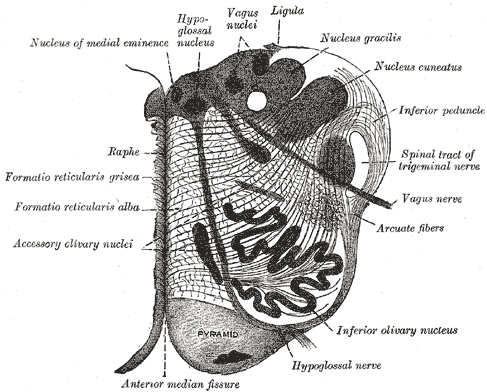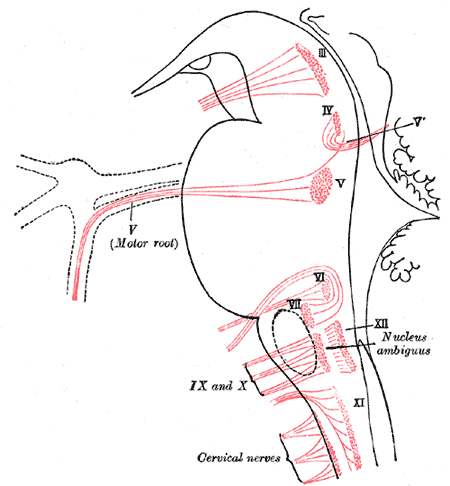Solitary nucleus
Editor-In-Chief: C. Michael Gibson, M.S., M.D. [1]
The solitary nucleus and tract are structures in the brainstem that carry and receive visceral sensation and taste from the facial (VII), glossopharyngeal (IX), vagus (X) cranial nerves, as well as the cranial part of the accessory nerve (XI).
Anatomy
The nucleus is located along the length of the medulla (with a small portion in the lower pons). The solitary tract runs in the middle of the nucleus, creating a speck of white matter (axons of the tract), surrounded by grey matter (the nucleus). This stands out on a stained section, which is where the name solitary comes from.
The solitary nucleus is divided into a rostral (towards the top) gustatory nucleus and caudal (towards the bottom) cardiorespiratory nucleus. The cardiorespiratory nucleus can be further divided into a cardiovascular center, which sits at the midline of the nucleus, and a respiratory center, which is located laterally.
Inputs to the solitary nucleus
In addition to afferent taste information from nerves VII, IX and X, the solitary nucleus also handles primary afferent signals from a variety of visceral regions and organs. These afferents include chemoreceptors in the carotid (via IX) and aortic bodies (via X) as well as stretch receptors from the aorta and carotid arteries called arterial baroreceptors. In addition, chemically and mechanically sensitive neurons with endings located in the heart, lungs, airways, gastrointestinal system, liver and other viscera send axons via cranial nerves (IX and X) chiefly that directly enter the brainstem to form synapses within the caudal third of the solitary nucleus. Neurons that synapse in this nucleus mediate the gag reflex, the carotid sinus reflex, the aortic reflex, the cough reflex, the baroreceptor and chemoreceptor reflexes, several respiratory reflexes and reflexes within the gastrointestinal system regulating motility and secretion. Information about the gut wall, as well as stretch of the lungs and dryness of mucous membranes, also synapses at the solitary nucleus. These first central neurons within the solitary nucleus can participate in autonomic reflexes that may be as simple as two central neurons with the second neuron being an efferent or motor neuron that projects back directly to the organ such as the heart forming some of the simplest reflex pathways in the brain.
Outputs from the solitary nucleus
Most information goes from the solitary nucleus to the hypothalamus and cingulate gyrus, as well as to other nuclei in the brainstem (such as visceral motor or respiratory centers).
Additional images
-
Section of the medulla oblongata at about the middle of the olive.
-
Nuclei of origin of cranial motor nerves schematically represented; lateral view.
-
Primary terminal nuclei of the afferent (sensory) cranial nerves schematically represented; lateral view.


